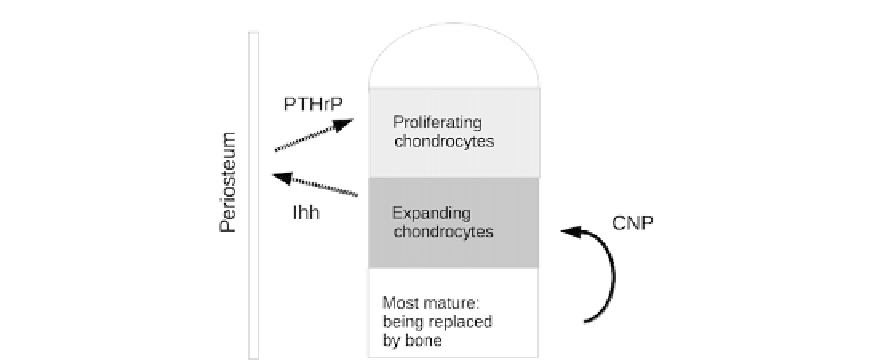Biology Reference
In-Depth Information
FIGURE 22.13
Local signalling loops arrange replacement of cells that enter a more mature compartment with
cells from a less mature one. The Ihh-PTHrP loop proceeds via the periosteum, and would be expected to become
less efficient as the bone grows larger. This may account for the relationship between existing bone size and rate of
growth, and therefore for catch-up growth by bones.
systems internal to the growth plate. The existence of these internal regulatory systems can be
demonstrated by an experiment in which the growth of a long bone in one rabbit limb is
inhibited experimentally during part of the growth period. The contralateral leg grows nor-
mally, but when the treated leg is released from inhibition it increases its own rate of growth
and catches up with the contralateral leg.
71
It is clear that, for this to happen, the treated leg
must be able to detect its own size. One hypothesis for how it might do so depends on a sig-
nalling loop that passes from the growth plate to the periosteum, on the outside of the bone,
and back. Within the growth plate, the balance of stem cells, proliferating chondrocytes,
expanding chondrocytes and maturing cartilage is set by local signals. As mature, expanding
chondrocytes commit to their final maturation and eventual death to make way for bone,
they signal back to the proliferating zone (using CNP) to encourage more proliferating cells
to enter the expanding chondrocyte phase and thus replace the most mature cells that will be
lost. This will have the desired effect of maintaining a population of expanding chondrocytes,
but at the expense of the proliferating chondrocytes. The cells making this decision signal
back to the most immature progenitor population to increase its proliferation and thus
maintain the size of the proliferating pool. This feedback signal is, however, indirect: the
cells secrete Indian Hedgehog, which diffuses to the periosteum. Here, cells respond
by secreting the peptide PTHrP,
72
which diffuses back to the growth plate and drives prolif-
eration of the stem cell population (
Figure 22.13
). The larger the bone has become, the
further the core of the growth plate will be from the periosteum and the longer and less effi-
cient the signalling loop will become (relying, as it does, on simple diffusion). The rate of
multiplication in the growth plate will therefore decrease the larger the bone has already
grown, even if GH concentrations remain the same. In this way, a retarded bone will auto-
matically catch up with its contralateral control, and we have the benefit of a right leg and
left leg that are about the same length as one another.

